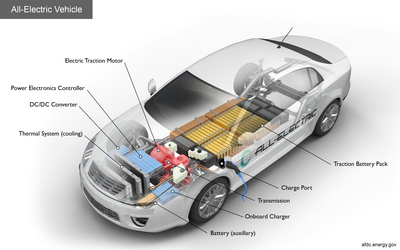Larry Nutson On Battery Electric Vehicles (BEV's)
LEARN MORE: Electric Vehicle Content Library
 |
Executive Producer, Chicago Bureau Chief
THE AUTO CHANNEL
It's not about reduced consumption of oil.
It's about cutting total emissions from all vehicles by 50% by 2035. Why? Climate. The earth is getting warmer. Too warm! The goal is to slow the earth's warming by 1.5ºC by 2050. Transportation is the biggest contributor of harmful green house gases. We need to reduce the number of ICE powered vehicles to help achieve this reduction. BEVs are very good. They drive just like an ICE powered vehicle. BEVs are especially suitable to urban, big city driving where distances are short. For someone who takes frequent long trips a HEV or PHEV might be the better choice, at this time. We will soon have BEVs with a 300 mile driving range.
The United States reentered the Paris Agreement, a climate treaty dedicated to lowering greenhouse gas emissions in more than 180 countries around the world. In my opinion, the U.S. never should have left under the past administration. The legally binding agreement aims to substantially reduce global greenhouse gas emissions in an effort to limit the global temperature increase in this century to 2 degrees Celsius above preindustrial levels, while pursuing the means to limit the increase to 1.5 degrees.
A number of European large cities have restrictions on using ICE vehicles within certain city centers. For example, London taxis are required to be PHEV and operate only on battery power in the heart of the city. Around 2,500 are in operation. I believe we will see this come to U.S. cities in locations like lower Manhattan and the Chicago loop to reduce localized vehicle emissions.
Automakers are interested to build and sell BEVs because they are easier and cheaper to build. They require fewer parts and less manpower. Yes, currently BEV batteries are pricey. Cost is coming down. By 2025 a BEV is expected to be on price parity with an equivalent ICE vehicle of the same model.
Additionally, with the globalization of the auto industry there is strong financial motivation to build the same vehicle for the whole world. Asian and European cities are pushing the zero-emission requirement.
Charging infrastructure is a big issue that needs work. Cities need to develop charging solutions for people who live in multi-unit dwellings (MUD) and park in large garages or on the street. Kansas City is doing a program to install EV charges on street light poles. The U.S. DoE is leading a program in a number of cities to work on MUD charging solutions.
A US.DoE report says there are 25 states that have at least 1,000 non-residential electric vehicle (EV) charging units (public and private). California has by far the greatest number of non-residential EV chargers with nearly 37,000 units. New York, Florida, and Texas had well over 4,000 each, while 11 other states had more than 2,000. Another 500,000 chargers are planned to be installed by 2030.
BEVs have been around for 100 years. Lots of research and development has been done in recent decades. I personally drove a BEV Volkswagen Golf at an alternative-fuels conference in Michigan back in 1992. That's thirty years ago. The auto industry has made lots of progress.
Airplanes, buses, semi-trucks, local delivery trucks, refuse trucks, municipal vehicles and more will start to appear all driven by battery power. By the way, BEVs operate more quietly than an ICE vehicle. The quality of life in neighborhoods will improve.
The globe needs help now to make it a safe and comfortable habitat for our grandchildren's children and generations beyond.
Stay safe. Be Well.



